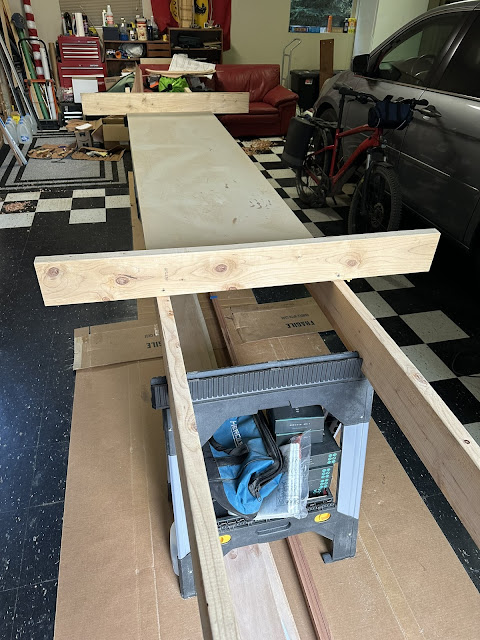I'm making very good progress. I brought home the Chesapeake Light Craft Annapolis Wherry one week ago, and yesterday was able to wire the hull together.
CLC does a very nice job in designing their panels. They use a puzzle joint that very accurately aligns the panels into the full-length planks.
After gluing up the final planks and storing them under my table, I adjusted the table to get ready to wire the hull.
The planks will need to be suspended between two sawhorses normally, but I'm very tall and bending over that much kills my back, so I simply removed one of the MDF boards that formed my table and shifted the other one to the middle. Then I screwed two 4' 2 x 6's to the ends of that MDF panel. That way, by using the factory edges, the 2 x 6's are aligned to each other. See the pictures below.
I store my completed planks and rails under the sawhorses until needed. That way they are mostly out of the way and stay flat.
After making sure that the 2 x 6s were level to each other, I started to wire the hull.
Here are the two #1 planks suspended between the boards. The hull will start to form a rocker as it's wired so you can't build it on a table. Also wires will be too hard to twist if on a table. You really must suspend the planks. Yes, they are very floppy at this point, but be gentle and they will be fine.
About three hours later, the ten planks were all wired together and ready to be brought up into a finished hull form. This is how they look when wired together. They do start to round up. I was able to get them wired solo, but it would be easier if you have a helper while adding the first wires on planks #4 and #5.
I started with the bow, then added the transom, and finally the bulkheads. Your fingers will be very sore by the time you're done!
The bulkheads are a bear to install, but if you tighten the wires enough you can get the bulkheads to settle down nicely.
You'll notice in the picture below that I've trimmed the two middle bulkheads at the tops to accommodate the future spacered inwales.
Tomorrow I'll roll the hull over, tighten all the wires, and the epoxy all the planks together!
Stay tuned!










Comments
Post a Comment